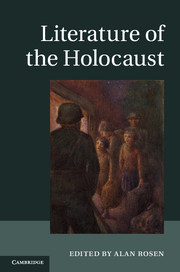Book contents
- Frontmatter
- Contents
- Notes on contributors
- Acknowledgments
- Introduction
- Part I Wartime victim writing
- Part II Postwar responses
- Part III Other approaches
- Chapter 12 Oral memoir and the Shoah
- Chapter 13 Songs of the Holocaust
- Chapter 14 Sephardic literary responses to the Holocaust
- Chapter 15 Anthologizing the Holocaust
- Chapter 16 The historian’s anvil, the novelist’s crucible
- Guide to further reading
- Index
- References
Chapter 16 - The historian’s anvil, the novelist’s crucible
Published online by Cambridge University Press: 05 June 2014
- Frontmatter
- Contents
- Notes on contributors
- Acknowledgments
- Introduction
- Part I Wartime victim writing
- Part II Postwar responses
- Part III Other approaches
- Chapter 12 Oral memoir and the Shoah
- Chapter 13 Songs of the Holocaust
- Chapter 14 Sephardic literary responses to the Holocaust
- Chapter 15 Anthologizing the Holocaust
- Chapter 16 The historian’s anvil, the novelist’s crucible
- Guide to further reading
- Index
- References
Summary
“The concentration camp is imaginable only and exclusively as literature, never as reality,” Imre Kertész has written, “least of all, when we have directly experienced it.” Kertész’s heterodox assessment of the relationship between historical fact and artistic representation underpins Fatelessness (1975), a novel based on his experience as a teenage prisoner in Auschwitz and Buchenwald, but narrated in a voice whose thoroughgoing naïveté imbues familiar scenes with a bewildering sense of wonder. In his strict allegiance to the powers of the imagination, Kertész sought to combat two totalitarian regimes, Nazism and postwar Soviet communism, that had stripped him of control over his own fate. The “fragile gift” of his life having been “expropriated by alien forces, and circumscribed, marked up, branded,” as he put it in his Nobel Prize Address, Kertész had to take it back “from ‘History,’ this dreadful Moloch, because it was mine and mine alone.”
Kertész’s provocative argument suggests the degree to which all of us today gain access to the Shoah through multiple forms of evidence, including contested modes of narrative reconstruction that are inherently “imaginative” – sometimes dangerously so. We need only bear in mind the cautionary tale of Binjamin Wilkomirski’s infamous memoir, Fragments (1995), which elicited moving corroboration from survivors, who acclaimed its acute reflection of their own experiences before it was proved to be pure fiction. Yet in revealing that the emotional authority of survivor testimony may be “autonomous from history,” as Michael Bernard-Donals puts it, Wilkomirski’s hoax also paradoxically demonstrated literature’s power to illuminate the Holocaust by, in effect, ventriloquizing the voice of history.
- Type
- Chapter
- Information
- Literature of the Holocaust , pp. 252 - 267Publisher: Cambridge University PressPrint publication year: 2013



